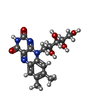+ Open data
Open data
- Basic information
Basic information
| Entry | Database: PDB / ID: 7lis | ||||||||||||
|---|---|---|---|---|---|---|---|---|---|---|---|---|---|
| Title | Thermotoga maritima Encapsulin Nanocompartment Pore Mutant S5D | ||||||||||||
 Components Components | Maritimacin | ||||||||||||
 Keywords Keywords |  VIRUS LIKE PARTICLE / VIRUS LIKE PARTICLE /  Encapsulin / Encapsulin /  Nanocompartment Nanocompartment | ||||||||||||
| Function / homology |  Function and homology information Function and homology information encapsulin nanocompartment / encapsulin nanocompartment /  Hydrolases; Acting on peptide bonds (peptidases) / Hydrolases; Acting on peptide bonds (peptidases) /  peptidase activity / iron ion transport / intracellular iron ion homeostasis / peptidase activity / iron ion transport / intracellular iron ion homeostasis /  proteolysis proteolysisSimilarity search - Function | ||||||||||||
| Biological species |    Thermotoga maritima (bacteria) Thermotoga maritima (bacteria) | ||||||||||||
| Method |  ELECTRON MICROSCOPY / ELECTRON MICROSCOPY /  single particle reconstruction / single particle reconstruction /  cryo EM / Resolution: 2.96 Å cryo EM / Resolution: 2.96 Å | ||||||||||||
 Authors Authors | Andreas, M.P. / Adamson, L. / Tasneem, N. / Close, W. / Giessen, T. / Lau, Y.H. | ||||||||||||
| Funding support |  Australia, Australia,  United States, 3items United States, 3items
| ||||||||||||
 Citation Citation |  Journal: Sci Adv / Year: 2022 Journal: Sci Adv / Year: 2022Title: Pore structure controls stability and molecular flux in engineered protein cages. Authors: Lachlan S R Adamson / Nuren Tasneem / Michael P Andreas / William Close / Eric N Jenner / Taylor N Szyszka / Reginald Young / Li Chen Cheah / Alexander Norman / Hugo I MacDermott-Opeskin / ...Authors: Lachlan S R Adamson / Nuren Tasneem / Michael P Andreas / William Close / Eric N Jenner / Taylor N Szyszka / Reginald Young / Li Chen Cheah / Alexander Norman / Hugo I MacDermott-Opeskin / Megan L O'Mara / Frank Sainsbury / Tobias W Giessen / Yu Heng Lau /   Abstract: Protein cages are a common architectural motif used by living organisms to compartmentalize and control biochemical reactions. While engineered protein cages have featured in the construction of ...Protein cages are a common architectural motif used by living organisms to compartmentalize and control biochemical reactions. While engineered protein cages have featured in the construction of nanoreactors and synthetic organelles, relatively little is known about the underlying molecular parameters that govern stability and flux through their pores. In this work, we systematically designed 24 variants of the encapsulin cage, featuring pores of different sizes and charges. Twelve pore variants were successfully assembled and purified, including eight designs with exceptional thermal stability. While negatively charged mutations were better tolerated, we were able to form stable assemblies covering a full range of pore sizes and charges, as observed in seven new cryo-EM structures at 2.5- to 3.6-Å resolution. Molecular dynamics simulations and stopped-flow experiments revealed the importance of considering both pore size and charge, together with flexibility and rate-determining steps, when designing protein cages for controlling molecular flux. | ||||||||||||
| History |
|
- Structure visualization
Structure visualization
| Movie |
 Movie viewer Movie viewer |
|---|---|
| Structure viewer | Molecule:  Molmil Molmil Jmol/JSmol Jmol/JSmol |
- Downloads & links
Downloads & links
- Download
Download
| PDBx/mmCIF format |  7lis.cif.gz 7lis.cif.gz | 58.1 KB | Display |  PDBx/mmCIF format PDBx/mmCIF format |
|---|---|---|---|---|
| PDB format |  pdb7lis.ent.gz pdb7lis.ent.gz | 44.1 KB | Display |  PDB format PDB format |
| PDBx/mmJSON format |  7lis.json.gz 7lis.json.gz | Tree view |  PDBx/mmJSON format PDBx/mmJSON format | |
| Others |  Other downloads Other downloads |
-Validation report
| Arichive directory |  https://data.pdbj.org/pub/pdb/validation_reports/li/7lis https://data.pdbj.org/pub/pdb/validation_reports/li/7lis ftp://data.pdbj.org/pub/pdb/validation_reports/li/7lis ftp://data.pdbj.org/pub/pdb/validation_reports/li/7lis | HTTPS FTP |
|---|
-Related structure data
| Related structure data |  23384MC  7liiC  7lijC  7likC  7lilC  7limC  7litC M: map data used to model this data C: citing same article ( |
|---|---|
| Similar structure data |
- Links
Links
- Assembly
Assembly
| Deposited unit | 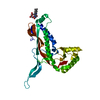
|
|---|---|
| 1 | x 60
|
| 2 |
|
| 3 | x 5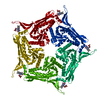
|
| 4 | x 6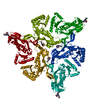
|
| 5 | 
|
| Symmetry | Point symmetry: (Schoenflies symbol : I (icosahedral : I (icosahedral )) )) |
- Components
Components
| #1: Protein | Mass: 30091.287 Da / Num. of mol.: 1 / Mutation: E184D,P189D, Del(185-188) Source method: isolated from a genetically manipulated source Source: (gene. exp.)    Thermotoga maritima (strain ATCC 43589 / MSB8 / DSM 3109 / JCM 10099) (bacteria) Thermotoga maritima (strain ATCC 43589 / MSB8 / DSM 3109 / JCM 10099) (bacteria)Strain: ATCC 43589 / MSB8 / DSM 3109 / JCM 10099 / Gene: TM_0785 / Production host:   Escherichia coli BL21(DE3) (bacteria) Escherichia coli BL21(DE3) (bacteria)References: UniProt: Q9WZP2,  Hydrolases; Acting on peptide bonds (peptidases) Hydrolases; Acting on peptide bonds (peptidases) |
|---|---|
| #2: Chemical | ChemComp-RBF /  Riboflavin Riboflavin |
| Has ligand of interest | N |
-Experimental details
-Experiment
| Experiment | Method:  ELECTRON MICROSCOPY ELECTRON MICROSCOPY |
|---|---|
| EM experiment | Aggregation state: PARTICLE / 3D reconstruction method:  single particle reconstruction single particle reconstruction |
- Sample preparation
Sample preparation
| Component | Name: Thermotoga maritima Encapsulin Nanocompartment Pore Mutant S5D Type: COMPLEX Details: Thermotoga maratima encapsulin pore mutant with E184D, P189D, and deletion of amino acids A185-Y188 Entity ID: #1 / Source: RECOMBINANT | |||||||||||||||
|---|---|---|---|---|---|---|---|---|---|---|---|---|---|---|---|---|
| Molecular weight | Value: 1.825782 MDa / Experimental value: NO | |||||||||||||||
| Source (natural) | Organism:    Thermotoga maritima MSB8 (bacteria) Thermotoga maritima MSB8 (bacteria) | |||||||||||||||
| Source (recombinant) | Organism:   Escherichia coli BL21(DE3) (bacteria) Escherichia coli BL21(DE3) (bacteria) | |||||||||||||||
| Buffer solution | pH: 8 | |||||||||||||||
| Buffer component |
| |||||||||||||||
| Specimen | Conc.: 2 mg/ml / Embedding applied: NO / Shadowing applied: NO / Staining applied : NO / Vitrification applied : NO / Vitrification applied : YES : YES | |||||||||||||||
| Specimen support | Grid type: C-flat-2/2 | |||||||||||||||
Vitrification | Instrument: FEI VITROBOT MARK IV / Cryogen name: ETHANE / Humidity: 95 % / Chamber temperature: 277 K / Details: blot force 0, wait time 30 seconds |
- Electron microscopy imaging
Electron microscopy imaging
| Microscopy | Model: TFS TALOS |
|---|---|
| Electron gun | Electron source : :  FIELD EMISSION GUN / Accelerating voltage: 200 kV / Illumination mode: FLOOD BEAM FIELD EMISSION GUN / Accelerating voltage: 200 kV / Illumination mode: FLOOD BEAM |
| Electron lens | Mode: BRIGHT FIELD Bright-field microscopy / Nominal defocus max: -2500 nm / Nominal defocus min: -1000 nm Bright-field microscopy / Nominal defocus max: -2500 nm / Nominal defocus min: -1000 nm |
| Specimen holder | Cryogen: NITROGEN |
| Image recording | Average exposure time: 47.84 sec. / Electron dose: 40 e/Å2 / Film or detector model: FEI FALCON III (4k x 4k) |
| Image scans | Movie frames/image: 40 |
- Processing
Processing
| EM software |
| ||||||||||||||||||||||||||||||||||||||||
|---|---|---|---|---|---|---|---|---|---|---|---|---|---|---|---|---|---|---|---|---|---|---|---|---|---|---|---|---|---|---|---|---|---|---|---|---|---|---|---|---|---|
CTF correction | Type: PHASE FLIPPING AND AMPLITUDE CORRECTION | ||||||||||||||||||||||||||||||||||||||||
3D reconstruction | Resolution: 2.96 Å / Resolution method: FSC 0.143 CUT-OFF / Num. of particles: 33416 / Symmetry type: POINT | ||||||||||||||||||||||||||||||||||||||||
| Atomic model building | B value: 51.86 / Protocol: FLEXIBLE FIT / Space: REAL | ||||||||||||||||||||||||||||||||||||||||
| Atomic model building | PDB-ID: 3DKT Pdb chain-ID: A / Pdb chain residue range: 1-265 |
 Movie
Movie Controller
Controller









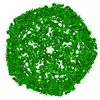

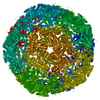





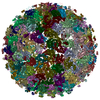
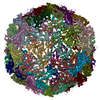
 PDBj
PDBj
